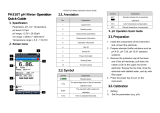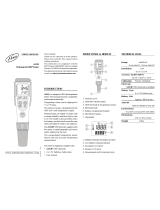
12
• When the reading is stable and close to the selected buffer, the “CFM”
tag will blink and if enabled, an audible signal will sound.
• Press the CFM key to confirm the calibration. The calibrated value
will be displayed on the primary LCD and the second expected buffer
value on the secondary LCD.
• After the first calibration point is confirmed, submerse the pH electrode
and the temperature probe approximately 3 cm (1¼”) into the second
buffer solution and stir gently. The temperature probe should be close
to the pH electrode.
• If necessary, press the ARROW keys to select a different buffer value.
Note: The instrument will automatically skip the buffer used for
the first point. It also skips 6.86 if 7.01 was used, and vice versa.
Likewise, it will skip 9.18 if 10.01 has been used, and vice versa.
• The “ ” tag will blink on the LCD until the reading is stable.
• When the reading is stable and close to the selected buffer the “CFM”
tag will blink.
• Press CFM to confirm calibration.
• The calibrated value is then displayed on the
primary LCD and the third expected buffer value
on the secondary LCD.
• After the second calibration point is confirmed, submerse the pH
electrode and the temperature probe approximately 3 cm (1¼”)
into the next buffer solution and stir gently. The temperature probe
should be close to the pH electrode.
• If necessary, press the ARROW keys to select a different buffer value.
• The “ ” tag will blink on the LCD until the reading is stable.
• When the reading is stable and close to the selected buffer the “CFM”
tag will blink.
• Press CFM to confirm calibration.
• After the third calibration point is confirmed,
submerse the pH electrode and the temperature
probe approximately 3 cm (1¼”) into the next
buffer solution and stir gently. The temperature probe should be
close to the pH electrode.
• If necessary, press the ARROW keys to select a different buffer value.
• The “ ” tag will blink on the LCD until the reading is stable.























